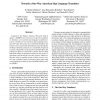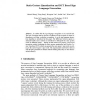99
Voted
FGR
2004
IEEE
15 years 4 months ago
2004
IEEE
Inspired by the Defense Advanced Research Projects Agency's (DARPA) recent successes in speech recognition, we introduce a new task for sign language recognition research: a ...
82
Voted
ACII
2005
Springer
15 years 5 months ago
2005
Springer
To collect data for sign language recognition is not a trivial task. The lack of training data has become a bottleneck in the research of singer independence and large vocabulary r...
129
Voted
ICMI
2005
Springer
15 years 6 months ago
2005
Springer
Sign language recognition (SLR) plays an important role in human-computer interaction (HCI), especially for the convenient communication between deaf and hearing society. How to e...
125
click to vote
IBPRIA
2005
Springer
15 years 6 months ago
2005
Springer
Sign language recognition constitutes a challenging field of research in computer vision. Common problems like overlap, ambiguities, and minimal pairs occur frequently and require...
119
click to vote
GW
2005
Springer
15 years 6 months ago
2005
Springer
Abstract. A sign language recognition system based on Hidden Markov Models(HMMs) and Auto-regressive Hidden Markov Models(ARHMMs) has been proposed in this paper. ARHMMs fully cons...
106
click to vote
GW
2005
Springer
15 years 6 months ago
2005
Springer
Hitherto, one major challenge to sign language recognition is how to develop approaches that scale well with increasing vocabulary size. In large vocabulary speech recognition real...
89
Voted
GW
2005
Springer
15 years 6 months ago
2005
Springer
In Sign Language recognition, one of the problems is to collect enough data. Data collection for both training and testing is a laborious but necessary step. Almost all of the stat...
98
Voted
ASSETS
2006
ACM
15 years 6 months ago
2006
ACM
CopyCat is an American Sign Language (ASL) game, which uses gesture recognition technology to help young deaf children practice ASL skills. We describe a brief history of the game...
ICPR
2006
IEEE
15 years 6 months ago
2006
IEEE
This paper presents a unified system for segmentation and tracking of face and hands in a sign language recognition using a single camera. Unlike much related work that uses colou...
99
Voted
ICASSP
2009
IEEE
15 years 7 months ago
2009
IEEE
We address multistream sign language recognition and focus on efficient multistream integration schemes. Alternative approaches are investigated and the application of Product-HM...


